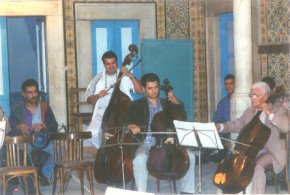| (i) The Rashidiyya and radio ensembles: Tunisie
Anthologie du Maluf L'utilisation des instruments à cordes d'origine européenne à côté des instruments traditionnels et la fixation de la musique nécessaire aux grandes formations, ont conféré à l'interprétation du malouf une âme et une dimension nouvelles. Ces éléments n'ont nullement trahi l'authenticité de cette musique grâce notamment à la perpétuation des formes mélodiques et des ornements qui en sont spécifiques. (Zghonda 1999: no page number.) For the Rashidiyya, the key to authenticity in interpreting the ma’luf is to be found in its melodic essence. The radical expansion of the ensemble in the 1930s with its unprecedented instrumental doublings, its emphasis on bowed string and choral timbres in both upper and lower registers and its exclusion of the solo voice, were considered legitimate in that they in no way compromised the melodic integrity of the tradition. This view is in marked contrast with that of d’Erlanger and indeed, the majority of the European delegates to the 1932 Cairo Congress, for whom authenticity in Arab music resided as much in the quality and balance of the vocal and instrumental timbres as in the melodic substance itself (10). The Ministry of Culture has continued to promote the lush instrumental and choral sounds of the Rashidiyya through the 1990s in a series of recordings produced jointly with the Maison des Cultures du Monde (Paris) under the label 'Inedit,' entitled Tunisie Anthologie du Ma'luf. Subtitled enregistrements historiques, the first four volumes reproduce the original archival recordings of the Radio ma'luf ensemble made around 1960, conducted by Abdulhamid Belalgia with chorus master Khemais Tarnane. Nubat al-dhil (1959) and nubat al-ramal (1960) were released in 1992 and nubat al-'iraq (1960 and nubat al-asbahan (1962) in 1993. The fifth volume, in contrast, features a contemporary
performance of nubat al-sika by an ensemble formed
specially for the occasion from among leading musicians
of the Rashidiyya and Radio ensembles with Fethi Zghonda,
head of music in the Ministry of Culture, as conductor.
Notwithstanding the ensemble's reduced size (it comprises
five violins, a cello, nay, 'ud tunsi, qanun, tar,
naqarrat and a chorus of 5 men and 5 women) the essential
features of the Rashidiyya's distinctive sound and
performance practice are retained: the conductor and
instrumentalists perform from notation and the
predominant timbre is that of unison violins and chorus.
The sixth and latest contribution to
the series is a recording of nubat al-hsin made in 1999,
performed by the Rashidiyya ensemble conducted by
Abdulhamid Belalgia with chorus master Tahar Gharsa. This
last recording was produced jointly by the Tunisian
Ministry of Culture and the Centre des Musiques Arabes et
Mediterraneennes "Ennejma Ezzahra." In the
liner notes, Fethi Zghonda observes that the Rashidiyya
ensemble with its 'quarantaine de musicians parmi les
meilleurs en Tunisie,' is considered 'comme reference en
matiere de musique traditionelle tunisienne' (Zghonda
1999: no page numbers).
The Rashidiyya ensemble in rehearsal (details) For Abdulhamid Belalgia, leader in all but one volume in the series, the concept of authenticity extends beyond the limits of any one melodic version. When the Rashidiyya embarked on its transcription project in the 1930s, the very notion of melodic tradition, even when defined in notation, was fluid and variable. The original transcriptions were understood to be authoritative, but not definitive: their primary purpose was to unify the diverse interpretations of the shaykhs in order to create a viable performance practice for the newly enlarged ensemble (11). The very need to make the transcriptions arose out of the historic diversity of the oral tradition and from the outset, the Rashidiyya recognised the validity of alternative notations. In the archive of the Rashidiyya, I discovered different versions of the same melodies notated by successive leaders of the ensemble. It was only after independence, under the influence of nationalist ideology, that the concept of a unitary national tradition took root and the published notations were promoted throughout Tunisia as the sole correct version of the melodies. For some, including Belalgia, the concept of a single correct version remained untenable. When he led the radio ensemble in the ma’luf recordings of the 1960s, Belalgia transcribed his own versions of the melodies which differ in significant details from the versions recorded by the Rashidiyya at that time. Belalgia continues to use the same transcriptions as current leader of the Rashidiyya. In defence of his practice, he points to its roots in oral tradition, drawing parallels with the shaykhs of old who likewise taught their distinctive versions of the melodies to their ensembles. Tahar Gharsa, currently chorus master of the Rashidiyya, claims to have notated unique versions of the melodies taught to him by his mentor, Shaykh Khemais Tarnane. Both Gharsa and Belalgia defend the authority of their melodic versions on grounds of authenticity rather than originality – an authenticity which, they claim, is derived from their personal experience of the oral traditions of the shaykhs. |

